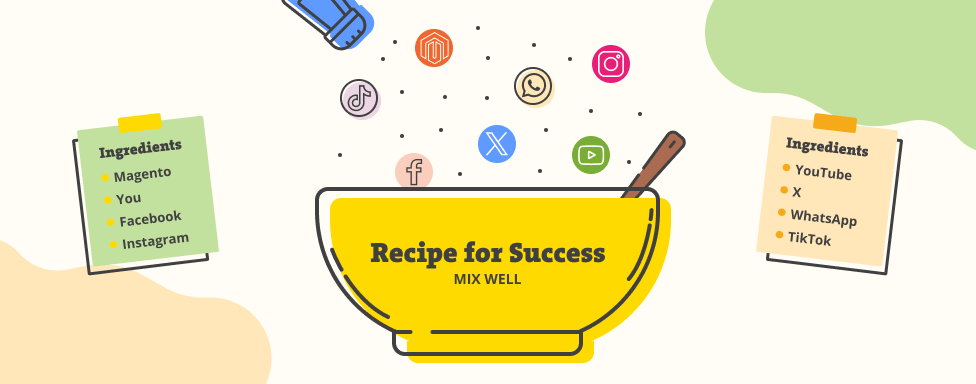In 2025, content is no longer just a blog post here and a product description there. Content Marketing Strategy the backbone of your brand experience, your organic growth engine, and a key differentiator in an increasingly commoditized online market.
AI-generated content, zero-click search results, TikTok commerce, voice interfaces, and hyper-personalized shopping journeys have raised the bar. At the same time, consumers are savvier than ever. They can smell generic, lazy content from miles away. Or even workse – lack of content.
If you’re running an online store today, your content marketing needs to do four jobs at once:
- Attract new audiences through SEO, social, and shareable formats.
- Educate and build trust through helpful resources, demos, and storytelling.
- Convert users with smart content experiences—think guided selling tools, explainer videos, and social proof.
- Retain and re-engage customers with ongoing value: newsletters, how-tos, insider updates, and community building.
This guide will help you cut through the clutter and build a content strategy designed for how people buy in 2025. We’ll walk through the tech stack, team setup, formats, distribution, and KPIs you need to stay ahead and stay profitable.
Whether you’re running on Shopify, Magento, WooCommerce, or a headless custom solution, this guide is built to give you practical, scalable advice you can apply today.
1. Build a Cross-Functional Content Team
This is usually the tricky part for many organizations. You’d love to do it but you don’t have time for it and everybody in the organization seems so act as if it isn’t their job to prepare content. So, whose job is it? This depends on the size of the company, but in most cases it’s a very collective effort of several departments:
- Marketing Department is your obvious first choice when it comes to content marketing. They should really carry the whole story and make sure everyone else including themselves fulfills the content marketing goals. Their job is also to measure the results and predict the future growth. With time they need to figure out what type of content works best for your ROI and prioritize that content.
- PR department, if you have one, is obviously going to write some content for you. Make sure marketing folks explain them what kind of content they need every month.
- Support Department will give you some of the most useful content you can have on your e-commerce website. They can update product descriptions to include the answers to the commonly asked questions about those products, they can write the Q&A section and knowledge base entries and more!
- Designers can be an amazing force in your content marketing team. Combining them with marketers who feed them data, they can create beautiful infographics that your users will love to share via social networks!
- Even developers can contribute to your content marketing strategy by filming screencasts or writing tutorials on how to use some of the new features you implement into your online store for the users.
It will be hard to create a culture of generating content within your organization, especially if you were historically a very “closed” company that keeps its “secrets” to itself. You will need to push hard a new corporate culture and explain to employees that it’s actually good to share what they’re doing publicly and encourage such behavior.
It might be a good idea to schedule your content creation activities in advance if your corporate culture is not such that people will be very proactive about creating content. Here is a little guide that will help you do it for a year in advance.
2. Generate amazing data driven content ideas
In the beginning you’ll have lots of stuff to write about, however, as time goes by, you’ll start running out of ideas. This is where to get great article ideas for your e-commerce content marketing:
- Extract content ideas from the site search data is something you should do often. Analyze on-site searches, Google Analytics, Google Search Console trends, and social listening. See if there are any new terms that people search for within your website but you still don’t have a page that would answer that query. Write that page!
- Seasonal content is something you can write about that’s relevant to this season only. Depending on your niche, this might be the new fall collection, the latest trends in your industry, the best things to buy from your store as presence for the holiday season, the must have items for summer vacation etc.
- Run customer segmentation to tailor content for distinct buyer personas.
- Evergreen support content is something your support department will write, which answers questions related to your products quality, tutorials on how to use your products to the fullest potential, technical installation instructions and advice in general.
- “Steal” ideas, but don’t steal content – there’s nothing wrong with taking an idea from someone else and making it better. That’s done in business every day, it’s how the world moves forward and technology advances. So, there’s nothing wrong with “stealing” and idea, as long as you just use the idea to write your own stuff, not steal the content itself.
3. Content is not just Text
When we say content, most of the people instantly imagine text. Text, however, is not the only form of content. In the modern web, we use several types of content to succeed in our content marketing efforts, so don’t forget about other types of content:
- Text – long, short, technical, artistic, all kinds of textual expressions go into the content marketing mix.
- Video – product demo video, short videos, stories, animations, in-depth YouTube tutorials, live shopping demos or any kind of video that brings value to your users should be in your content marketing mix.
- Interactive – AR try-ons, product finders, calculators, “what style suits you?” quizzes.
- Audio – mini‑podcasts on product tips, user interviews.
- Images and infographics – lately, infographics have proven to be “the next big thing” in content marketing. Presenting boring data in a beautiful illustrated picture where it can be visualized and easily understood by your customers can be the difference between no one reading your content and thousands of people sharing it!
- Downloads/Docs – whitepapers, Spreadsheet planners, eBooks.
4. Repurpose & Refresh Existing Content
Content ages fast. Keep it evergreen. Search for out of date articles published on your site with deprecated information and update them to reflect the current state. You can add data to existing articles and make them even more useful.
Another great thing to do is work on your product descriptions. There can be an amazing ROI potential in improving your product descriptions.
It’s not just text that you can improve, it’s images as well. Images you took years ago are probably uploaded in a poor resolution. Today, people have much faster internet connections and customer’s expectations for enlarged image view is becoming higher every day. If necessary retake the poor product images and upload new high resolution versions.
Even this post with the same topic was initially written by Toni Aničić in 2012. Refreshed now in 2025.
5. Encourage User Generated Content
In today’s eCommerce landscape, User-Generated Content (UGC) is no longer a “nice to have” thing. It’s a critical trust signal and a powerful driver of SEO, conversions, and community.
Consumers are bombarded with polished brand content. What cuts through? Real people using your products in real life. That’s where UGC shines.
Why it matters in 2025?
- Authenticity wins: Shoppers trust other shoppers more than they trust brands. Reviews, unboxing videos, and “TikTok hauls” bring raw, relatable proof that your product delivers.
- SEO boost: Customer reviews and Q&A add long-tail keywords and fresh content to product pages, increasing search visibility without lifting a finger.
- Conversion uplift: Pages with rich UGC (photos, testimonials, reviews) have significantly higher conversion rates. Seeing is believing.
- Content velocity: UGC fills your content pipeline organically, allowing you to scale promotion without constantly producing from scratch.
- Social proof loop: UGC fuels social media engagement, which in turn drives traffic back to your store.
6. Measure ROI Holistically
Too many brands invest in content without knowing if it actually works. Yes, content marketing can (and should) drive sales. But its true value unfolds across a wider set of signals: trust, visibility, retention, and efficiency.
To understand what’s working and where to double down, you need a clear measurement plan from the start. Not just a dashboard, but a structured approach that ties each content type to user intent and business goals.
7. Don’t give up too early
This is one of the most common reasons companies fail at content marketing. Content marketing takes some time to gain momentum and start bringing results, but once it starts, it’s an unstoppable force generating amazing ROI for your organization. With each day passing, you know you are closer to having an ultimate marketing strategy and an unfair advantage over your competitors as you build content for your users and they find you organically.
Bottom line
Bottom line: Content marketing in 2025 revolves around interactivity, personalization, automation, and integration across channels. With the right tools, mindset, and mindset, it’s still one of the most powerful ways to grow your e‑commerce business.



